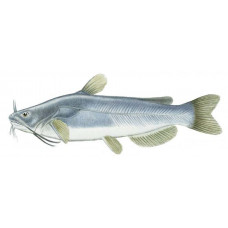Latin name
Ameiurus catus
Other names
Catfish
Identification
White catfish resemble a cross between a channel cat and a bullhead, with a slightly forked tail, broad head and stocky body. Medium sized specimens are often mistaken for a giant bullhead. The white catfish has a moderately forked tail, which distinguishes it from the flathead catfish and the bullhead, which do not have forked tails. Its anal fin is rounded at the edge and has 19 to 23 rays, which is less than the blue catfish or the channel catfish. Without close examination it can be confused with other catfish, although it does not have the spots seen on juvenile channel cats. This fish is olive or slate-grey on the head and bluish-grey or slate-grey on the back and sides, tapering to a white belly. Like other channel cats, the white catfish has heavy, sharp thoracic and dorsal spines and long mouth spines; the chin spines are white.
Distribution
The native range of the white catfish is freshwater and slightly brackish river waters along the Atlantic coast from southern New York to Florida. It is found along the Gulf Coast from Florida to Texas and has been introduced into some inland waters in the eastern and western United States, including several New England states, Oregon and Nevada, and is well established in California.
Habitat
White catfish inhabit the muddy bottoms of slow-moving streams and rivers, as well as ponds, lakes and slightly saline areas of tidal estuaries. They usually avoid the swift waters of large rivers and will not thrive in weedy or muddy shallow ponds.
Size
White catfish are smaller than their counterparts, but can grow to be larger than a bullhead. The world record for this species is a fish from Connecticut weighing 21lb 8oz, but a 22lb specimen has been recorded from California. These are the known upper limits for this species, but it can grow larger. Most fish are small, averaging 10 to 14 inches, and are often confused with bullheads. They are relatively slow growing fish, reaching sexual maturity at 3-4 years of age. They have been reported to live to 14 years, but can live much longer.
Life history and Behavior
This species spawns in spring and early summer, depending on latitude, and its spawning behaviour is generally similar to that of the bullhead. The parents build a nest on sandy or gravelly ground, usually near the shore and often in places associated with some form of shelter. Spawning occurs when the water reaches about 70°F and both parents guard the eggs and fry.
Food and feeding habits
White catfish are voracious eaters of aquatic insects, crayfish, molluscs, snails, mussels, fish roe, a variety of small fish and some aquatic plants. Adults feed mainly on fish and are nocturnal, although less so than other catfish.
Reproduction
No information
| Classification | |
| Phylum | Chordata |
| Class | Actinopterygii |
| Squad | Siluriformes |
| Family | Ictaluridae |
| Genus | Ameiurus |
| Species | A. catus |
| Features | |
| Conservation status | Least Concern |
| Habitat | Bottom |
| Life span, years | No information |
| Maximum body weight, kg | 4.5 |
| Maximum length, cm | 62 |
| Sailing speed, m/s | No information |
| Threat to people | Edible |
| Way of eating | Predator |


